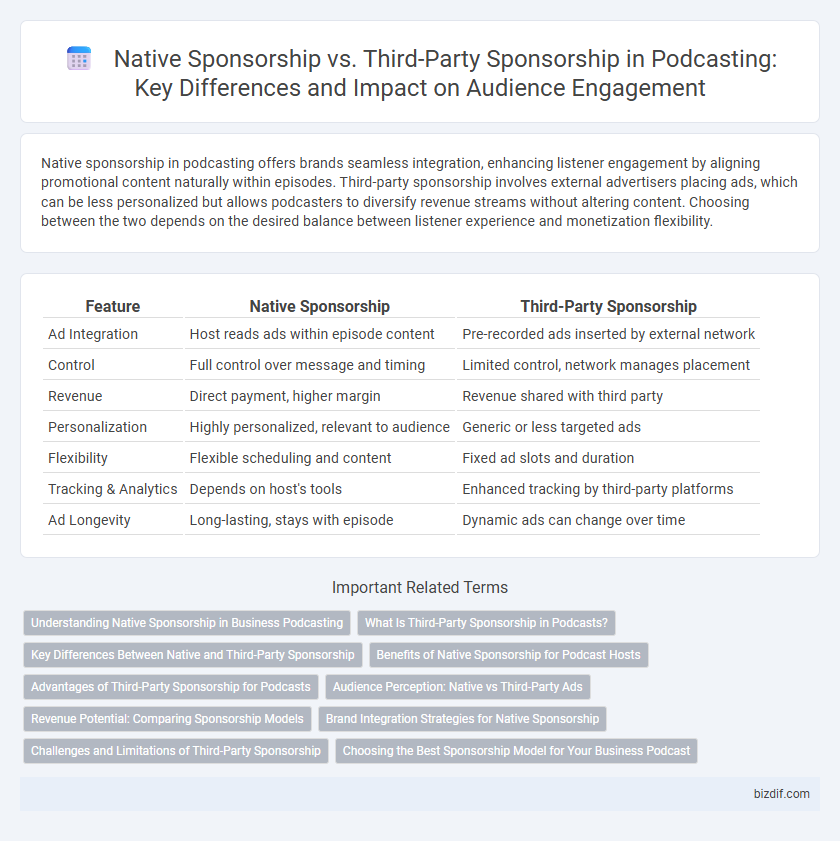Native sponsorship in podcasting offers brands seamless integration, enhancing listener engagement by aligning promotional content naturally within episodes. Third-party sponsorship involves external advertisers placing ads, which can be less personalized but allows podcasters to diversify revenue streams without altering content. Choosing between the two depends on the desired balance between listener experience and monetization flexibility.
Table of Comparison
| Feature | Native Sponsorship | Third-Party Sponsorship |
|---|---|---|
| Ad Integration | Host reads ads within episode content | Pre-recorded ads inserted by external network |
| Control | Full control over message and timing | Limited control, network manages placement |
| Revenue | Direct payment, higher margin | Revenue shared with third party |
| Personalization | Highly personalized, relevant to audience | Generic or less targeted ads |
| Flexibility | Flexible scheduling and content | Fixed ad slots and duration |
| Tracking & Analytics | Depends on host's tools | Enhanced tracking by third-party platforms |
| Ad Longevity | Long-lasting, stays with episode | Dynamic ads can change over time |
Understanding Native Sponsorship in Business Podcasting
Native sponsorship in business podcasting integrates brand messages seamlessly within the episode, creating a more authentic and engaging listener experience. This method typically results in higher audience trust and better conversion rates compared to third-party sponsorships, which often involve external ads inserted by platforms. Understanding the strategic value of native sponsorship helps podcasters align their content closely with sponsor values, enhancing brand affinity and long-term partnership success.
What Is Third-Party Sponsorship in Podcasts?
Third-party sponsorship in podcasts involves external brands or agencies that connect advertisers with podcast creators, managing ad placements and campaign logistics to broaden reach across multiple shows. This approach leverages established networks to efficiently target relevant audiences while reducing administrative burden for podcasters. It contrasts with native sponsorship, where advertisers collaborate directly with podcasts to create custom, integrated ad content that aligns closely with the show's tone and listener preferences.
Key Differences Between Native and Third-Party Sponsorship
Native sponsorship integrates brand messages directly into podcast content, creating a seamless and authentic listener experience with higher engagement rates. Third-party sponsorship involves external advertisements inserted independently from the podcast's content, often leading to lower listener retention. Native sponsorship typically offers better targeting and personalization, while third-party sponsorship provides broader reach but less contextual relevance.
Benefits of Native Sponsorship for Podcast Hosts
Native sponsorship in podcasting offers hosts greater control over the content and integration of ads, resulting in more authentic and engaging listener experiences. This approach often leads to higher listener trust and increased ad effectiveness, as the host's genuine endorsement resonates better with the audience. Revenue from native sponsorships tends to be more stable and potentially higher, providing podcast creators with sustainable financial support.
Advantages of Third-Party Sponsorship for Podcasts
Third-party sponsorship offers podcasts access to a broader range of advertisers, increasing revenue potential and audience reach. These sponsors often bring professional marketing expertise, allowing podcasters to focus on content creation while benefiting from optimized ad placements. Furthermore, third-party sponsorships provide flexible agreements and diversified income streams, reducing dependency on a single advertiser.
Audience Perception: Native vs Third-Party Ads
Native sponsorship in podcasting integrates brand messages seamlessly into content, enhancing listener trust and engagement through authenticity. Third-party sponsorship often feels intrusive or disconnected, potentially causing audience skepticism and reduced ad effectiveness. Studies show that native ads yield higher listener recall and brand affinity compared to third-party promotions in podcast environments.
Revenue Potential: Comparing Sponsorship Models
Native sponsorship in podcasting often generates higher revenue potential by integrating brand messages directly within content, fostering authentic listener engagement and making ads less intrusive. Third-party sponsorship relies on external ad networks that provide scalability and ease of management but may yield lower per-episode revenue due to generic ad placements and limited customization. Podcasts leveraging native sponsorship typically experience increased advertiser loyalty and higher CPM rates, enhancing long-term monetization strategies.
Brand Integration Strategies for Native Sponsorship
Native sponsorship in podcasting leverages seamless brand integration by embedding the sponsor's message directly into the host's content, enhancing listener trust and engagement. This strategy ensures high contextual relevance, boosting brand recall and creating a more authentic connection with the audience. Compared to third-party sponsorship, native integration offers greater control over messaging and maintains the podcast's tone, leading to more effective brand storytelling.
Challenges and Limitations of Third-Party Sponsorship
Third-party sponsorship in podcasting often faces challenges such as limited brand integration and reduced listener trust due to generic ad placements that may not align with the podcast's content. These sponsorships can lead to inconsistent ad experiences, diminishing the authenticity and engagement that native sponsorships typically offer. Furthermore, third-party providers may lack detailed audience insights, restricting targeted advertising and reducing overall campaign effectiveness.
Choosing the Best Sponsorship Model for Your Business Podcast
Native sponsorship integrates brand messaging directly into podcast content, creating a seamless and authentic listener experience that often drives higher engagement and trust. Third-party sponsorship, managed by external agencies, offers scalability and ease by handling ad placements across multiple podcasts but may lack personalization. Evaluating your podcast's niche, audience loyalty, and resource capacity helps determine whether native sponsorship's tailored approach or third-party sponsorship's broader reach best supports your business goals.
Native sponsorship vs Third-party sponsorship Infographic

 bizdif.com
bizdif.com